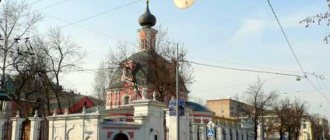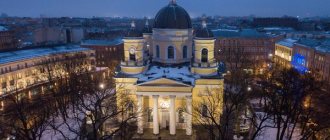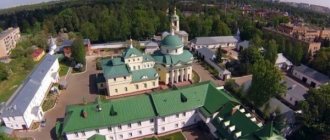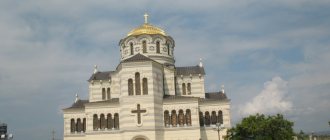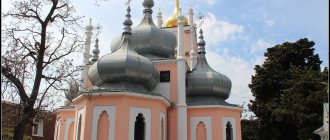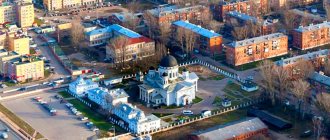The construction of the Catherine Cathedral in Tsarskoye Selo began at the behest of Emperor Nicholas I and the design of the architect Konstantin Ton in 1835. Five years later, it was consecrated by Protopresbyter Nikolai Muzovsky, who was engaged in the spiritual education of the first students of the Tsarskoye Selo Lyceum.
Today there are three altars in the church: the main one is consecrated in honor of the Holy Great Martyr Catherine, whose icon is also in the Znamenskaya Church, the other two are in the name of the royal martyrs and the blessed Alexander Nevsky. At one time, the city chapel named after this prince was attached to the cathedral, and now the Znamenskaya Church.
The temple did not survive the hard times of Soviet times: in 1934 the authorities closed it, and five years later they blew it up without a shadow of pity. The cross erected in 1994 reminds us of this.
The cathedral was restored in 2009, and today it is one of the brightest pearls of local architecture. The landscape surrounding the cathedral was also beautified, once organized by the skilled gardener Fyodor Lyamin, who decorated the cathedral territory with beautiful Dutch poplars.
Construction of the Cathedral of St. Catherine the Great Martyr
In 1835, construction began on the Cathedral of the Holy Great Martyr Catherine in Tsarskoye Selo according to the design of Konstantin Ton, approved by Emperor Nicholas I himself. Funds were allocated personally by the Emperor. The three largest bells for the new temple were cast in Yaroslavl by personal order of the emperor.
The painting of the cathedral was entrusted to the painters Fyodor Bryullov, Fyodor Bruni and Alexei Egorov. In particular, it was Bryullov who wrote the twelve prophets, Bruni - the image of St. Catherine, the Last Supper and the image of the Holy Blessed Prince Alexander Nevsky. The iconostasis for the temple was five-tiered; in addition, it was gilded and decorated with skillful carvings.
Five years later, in 1840, the cathedral stood before the parishioners in all its glory, and already on November 24 (old style), the emperor’s confessor, Protopresbyter Nikolai Muzovsky, consecrated it in the presence of the emperor, the heir to the throne, Tsarevich Alexander and the entire court. After the opening of the cathedral, the adjacent Tsarskoe Selo square began to be called Cathedral Square.
The entire year of 1842 was devoted to decorating the area in front of the new temple. These works were supervised by garden master Fedor Fedorovich Lyamin. Poplars brought from Holland were planted, and paths leading to the cathedral were built.
Initially, St. Catherine's Cathedral was single-altar. In 1851-1852, two more chapels appeared: the right one - in the name of the Holy Blessed Prince Alexander Nevsky and the left one, consecrated in the name of Saints Constantine and Helena.
Like many churches in Russia, the history of the Catherine Cathedral is divided into three stages: - from its creation to the revolutionary events of 1917 - the life of the cathedral during the years of Soviet power until its destruction - revival
1) 1835—1917
The Tsarskoye Selo City Cathedral of the Holy Great Martyr Catherine was founded in 1835 on the instructions of Nicholas I. Construction was carried out according to plan and under the supervision of the architect Konstantin Ton. Funds for the construction were allocated by His Majesty's Cabinet.
The consecration of the cathedral took place on November 24 (December 6), 1840, by the emperor's confessor, Protopresbyter Nikolai Muzovsky, in the presence of Nicholas I himself and Tsarevich Alexander Nikolaevich. The cathedral was initially part of the diocesan department, and in the same year the clergy of the Znamenskaya Church was transferred to it with all salaries, consisting of an archpriest, a clergyman, two priests, a deacon, two sextons and sextons. In 1875, the vacancy of one sexton was abolished.
Throughout 1842, landscaping work was carried out on the temple square under the leadership of the garden master Fyodor Fedorovich Lyamin. 12 paths were built, converging towards the cathedral. 200 bluish poplars brought from Holland were also planted on the square.
The cathedral was damaged by a fire in the wooden Gostiny Dvor that occurred in 1862. The most significant damage was to the gilding of the domes. In 1865, due to rust, the domes of the cathedral were painted with kronhelm, and in 1869 - with yellow paint, leaving the lower four rows, which retained the gilding.
On June 15 (27), 1874, the clergy of the Catherine Cathedral turned to the city manager with a request to recast the cracked bell and create a special niche for it in the arch above the western facade. On October 11 (23), the bell was removed and in 1875 it was recast with increasing weight. In May of the same year, the priests of the cathedral turned to the city manager with a request to build a temporary wooden bell tower for the bell. In 1876, according to the design of architect A.F. Vidov, a temporary wooden bell tower was built in the southwestern part of Cathedral Square, not far from the main entrance of the cathedral. In 1889, the Lenten bell was raised to its original place without any changes to the facade. In 1910, the clergy of the Catherine Cathedral turned to the city authorities with a request to add “a columned bell tower, corresponding to the beauty of the temple, the construction of which would serve to commemorate the 200th anniversary of the founding of Tsarskoye Selo.” However, the bell tower was not built.
In April 1890, for the 50th anniversary, the largest renovation of the cathedral began, ending in November.
At the cathedral, in a two-story stone house on Kolpinskaya Street, the Catherine Parish School was located. At the beginning of the 20th century, about 180 students studied free of charge at the school.
Attached to the temple was the chapel of the Holy Blessed Prince Alexander Nevsky in the nearby Gostiny Dvor (built in 1862-1864).
2) 1917-1939
In 1917, the number of parishioners in the cathedral sharply decreased: “The rector of the Catherine Cathedral in Tsarskoe Selo, Archpriest N. Smirnov, notes that in his church during one festive all-night vigil there was only one pilgrim.”
From November 1916 until his death on October 31 (November 13), 1917, Archpriest John Kochurov served as the second priest in the cathedral.
At the end of October 1917, Tsarskoe Selo became the site of an armed conflict between Bolshevik armed forces and Cossack troops under the command of General P. N. Krasnov, who remained loyal to the Provisional Government.
October 30 (November 12), 1917, during the artillery shelling of Tsarskoye Selo by the Bolsheviks, Fr. John and other clergy of the cathedral participated in the procession with special prayers for “an end to internecine warfare.” On October 31 (November 13), 1917, Bolshevik detachments entered Tsarskoe Selo and the priests leading the religious procession were arrested; O. John was taken to the Tsarskoye Selo airfield and shot there in front of his son, a high school student. At the request of the parishioners, on November 4 (17) of the same year, Father John was buried in the cathedral tomb. November 24 (December 7).
The first “orders” to close the temple were registered in 1934. The requirements appeared before 1937.
On July 10, 1937, the architectural and planning department of the Leningrad City Council ordered the Detskoselsky district executive committee to gild the domes of the cathedral, but in August the order was canceled.
On March 12, 1938, the rector of the cathedral, Archpriest Theodore Zabelin, was relieved of this post, and on April 27, the twenty of the cathedral filed a petition with Metropolitan Alexy (Simansky) of Leningrad to send a new priest to the Catherine Cathedral, but received an oral response: “There are no priests, there is no one to send, and we will have to surrender the cathedral.”
On May 11, 1938, the twenty initiated the procedure for handing over the property of the cathedral. On June 1, 1938, the presidium of the Pushkin District Council filed a petition with the presidium of the Leningrad City Council to close the cathedral and demolish it “as not representing cultural value.” The request was granted. By decree of the Presidium of the Leningrad Oblast Executive Committee of July 11, 1938, Catherine's Cathedral was closed. A Special Commission organized on October 24, after examining the building, proposed using the building for a theater and cinema, and the basement as a gas shelter.
In May 1939, the cathedral was surrounded by a solid plank fence. Workers removed the roof, church furniture, iconostases and paintings were taken away. The icons were stabbed with axes and dumped in a heap, and then burned in the basement, in the temple ovens.
On June 10, 1939, at 5:30 a.m., St. Catherine's Cathedral was blown up. The blasting work was led by mining engineer E. N. Nielsen
Almost immediately, projects for the development of the former square appear:
- It was proposed to install a monument to A.S. Pushkin, a swimming pool with fountains and flower edging, and children's playgrounds.
- the creation of a large green area, a park and architectural ensemble, all dedicated to the work of A. S. Pushkin, “his poems, fairy tales, poems, tragedies and stories.”
- transform the square into a “pantheon of great people of the pre-revolutionary era.”
But the plans could not be implemented. By 1950, the mountain of remains of the Catherine Cathedral gradually settled and turned into an ordinary city square. On April 22, 1960, a monument to V.I. Lenin was unveiled on the site of the cathedral.
3) Restoration and Sanctification (2010)
In connection with the canonization of Archpriest John Kochurov by the Council of Bishops of the Russian Orthodox Church on December 4, 1994, on February 5, 1995, on the former Cathedral Square, next to the place where the Catherine Cathedral was located before its destruction, a seven-meter eight-pointed wooden cross was erected. For the installation of the cross, at the suggestion of the district prosecutor, an administrative case was opened against Archpriest Gennady Zverev, he was fined 388 thousand rubles, and ordered to dismantle the cross. In turn, Pushkin’s believers stated that they were ready to bear all the costs of dismantling the monument to Lenin. In April of the same year, the St. Petersburg City Hall commission decided to dismantle the monument to V.I. Lenin in Pushkin (as well as at the Warsaw Station).
For the first time, the restored St. Catherine’s Cathedral was mentioned in the investment project for the development of infrastructure in the central part of the city of Pushkin, which was compiled by St. Petersburg State University of Economics and Economics in 1998.
In 2000, the chief architect of the Tsarskoe Selo State Museum, A. A. Kedrinsky, completed a preliminary design for the reconstruction of the main square, which involved the restoration of the Catherine Cathedral in two stages.
On November 3, 2003, a new wooden cross, made entirely by hand on the Solovetsky Islands by monk George, was installed and consecrated on Cathedral Square. It was donated to the Tsarskoye Selo deanery by the Interregional Charitable Foundation “Revival of Architectural Monuments of the Russian North.”
On the night of April 5-6, 2004, the monument to V.I. Lenin was thrown from its pedestal by unknown persons (using a powerful automobile winch attached to a tree). As a result of the fall, the monument was broken.
On June 3, 2006, an expedition from the Institute of the History of Material Culture of the Russian Academy of Sciences began large-scale archaeological excavations of the foundation. On August 4, KGIOP raised the issue of the possible restoration of the temple, noting the need to conserve the discovered foundation and continue research work in the archives. On August 25, archaeological excavations of the cathedral’s foundation were completed, during which elements of engineering communications, remains of architectural details and church utensils were also discovered. On November 1, the foundation of the cathedral was preserved.
On July 20, 2006, the Charitable Foundation “Reconstruction of St. Catherine’s Cathedral in Tsarskoye Selo” was established (registered on October 26). On November 10, the Foundation approved a Charitable program for the reconstruction of the cathedral.
The foundation stone of the temple took place on December 7, 2006. In front of the future altar of the temple there is a memorial sign in the form of a stone, on which is engraved the inscription about the event that took place: “On this place a temple will be built - a monument as a tribute of deep respect to the selfless and majestic feat of the inhabitants of Tsarskoe Selo, in memory of the tragic days of 1917. (December 7, 2006)"
On February 13, 2007, the Government of St. Petersburg signed a decree on measures to carry out work to preserve the Cathedral of St. Catherine in Tsarskoe Selo. On February 15, the Scientific Council for the Preservation of Cultural Heritage of the Government adopted the Concept for the reconstruction of the cathedral according to the design of the architect A. V. Mikhalychev.
The foundation of the cathedral was reopened on April 7, 2007, then preparation and equipment of the construction site began. On October 16, the foundation of the cathedral was poured.
On November 26, 2008, the Chairman of the Russian Government V.V. Putin signed a decree on the creation of an organizing committee to prepare the celebration of the 300th anniversary of the founding of Tsarskoye Selo, the most important element of which will be the reconstruction of the cathedral.
On August 4, 2009, the central chapter was raised onto the temple building, and the next day - four small ones.
On December 7, 2009, the first Divine Liturgy was served in the cathedral under construction, and a new ring of seven bells, which is a copy of the lost one, was consecrated. The bells were installed on the belfry on February 11, 2010
On June 1, 2010, a mosaic icon of the Holy Great Martyr Catherine was installed on the facade, made by the creative workshop of Ekaterina Ogorodnikova based on a sketch by A. V. Mikhalychev.
June 27, 2010 (during the celebrations dedicated to the 300th anniversary of the founding of Tsarskoye Selo) Patriarch Kirill, co-served by Metropolitan of St. Petersburg and Ladoga Vladimir (Kotlyarov), Bishops of Solnechnogorsk Sergius (Chashin), Bishops of Peterhof Markell (Vetrova), Vyborg Nazarius (Lavrinenko) and the clergy of St. Petersburg churches, performed the rite of great consecration of the temple.
By January 19, 2014, gilding of all domes was completed.
Since 2021, after the appointment of its rector, Archpriest Nikita Zverev, as dean of the Tsarskoye Selo district, it is the central church of the deanery
History of Pushkin's Catherine Cathedral
In general, the 19th century passed almost calmly for the Cathedral of St. Catherine the Great Martyr. He was constantly under the patronage of the reigning house. Perhaps this is what contributed to his death during the Soviet years.
In 1862, the cathedral, which had not even stood for a quarter of a century, was damaged by fire. Due to the heat (Gostiny Dvor was burning), the gilding on its domes came off. But the damage was quickly repaired, and in 1865 the heads were covered with a special compound that protected them from rust.
In the year of celebrating the three-hundredth anniversary of the House of Romanov, a memorial service for the tsars and emperors of Russia was celebrated in the Catherine Cathedral.
Architectural motives
Famous for its original Russian architectural traditions, the building occupied one of the central places in the imperial residence. Suzdal style is both the embodiment of power and grace. The majestic 5-dome structure, raised at a height of 50 meters, was visible from many points in the city.
The arches located at the top were crowned with images of angels, and the snow-white walls gave a feeling of purity. The silhouette of the Holy Great Martyr Catherine on the eastern side of the building was illuminated by the first rays of the sun.
After the revolution
At the end of 1917, the Bolsheviks entered Tsarskoe Selo. The further fate of the temple could be easily predicted. In 1918, Tsarskoe Selo was renamed Detskoe Selo; this name remained until 1937, when the city was renamed Pushkin on the centenary of the death of the poet. In 1934, the Detskoselsky City Council registered several orders to close the Catherine Cathedral. From that moment on, the fate of the cathedral was sealed.
In 1938, the property of the cathedral was described, and the building was transferred to the Pushkin District Council “for cultural and defense purposes.” It was then decided that the cathedral "has no cultural value" and was closed with a proposal to use the building as a cinema.
However, in 1939, the temple building was surrounded by a solid fence, the roof was removed from it, the furniture and iconostases were taken out, the icons were smashed with axes and burned in the basement, after which on June 5, 1939, the Catherine Cathedral was blown up.
A pile of bricks from the blown up temple remained in the same place until 1950! Only by this year they had partly settled, partly had been taken away, and a city park was laid out on the site of the temple. In 1960, on April 22, a monument to Vladimir Ilyich Lenin was erected in the place where parishioners once prayed.
Renaissance
In the 1990s, talk began that the Catherine Church should be restored. The path to this turned out to be long. In 2006, archaeological excavations began at the site where the cathedral stood. The preserved foundation of the old temple was uncovered. At the same time, large-scale work was carried out in the archives.
On July 20, 2006, the first stone was laid and a memorial sign was installed. Throughout 2007, the preparatory work necessary to begin construction was carried out. On December 7 of the same year, the cathedral’s charitable foundation announced the start of the “Name Brick for the Wall of the Church” campaign, and by December 23, the first thousand people had taken part in it! Truly, the restoration of the temple became a national affair.
In August 2009, five domes were installed on the church building, and in December of the same year the first liturgy was celebrated. In February 2010, bells were installed on the belfry - an exact copy of those that were once lost. The facade of the temple was decorated with a mosaic icon of St. Catherine and, when the tercentenary of Tsarskoe Selo was celebrated on June 27, 2010, the rite of great consecration of the temple was performed.
Inside Pushkin's Catherine Cathedral
Initially, the Catherine Cathedral in Pushkino was single-altar; two chapels were built later. In the restored temple from the very beginning there were three thrones. As before, the main altar was consecrated in the name of the Holy Great Martyr Catherine, but the right and left ones were consecrated in the name of the holy new martyrs of Russia. The right one is in the name of the holy royal passion-bearers, and the left one is in the name of the Hieromartyr John of Tsarskoye Selo (Kochurov).
The interior of the cathedral amazes with its grandeur, abundance of light and spaciousness. The walls of the cathedral have not yet been painted. Against the white background of the walls, the golden decoration of the icon cases and iconostases looks especially impressive. The door portals are decorated in pink marble. However, the main colors of the cathedral are gold and white.
The central iconostasis was restored the same as it was in the old church, according to a sketch by Konstantin Ton. White, with gilded details, directed upward, it looks very regal. But there is also a significant difference from the previous iconostasis: all of its icons are painted in the Old Russian style.
The icon of the Holy Great Martyr Catherine is located in a white and gold icon case near the southeastern pillar.
At the northeastern pillar, in exactly the same icon case, there is an image of the Holy Martyr John of Tsarskoye Selo. On the salt under the icon cases there are reliquaries with the relics of these saints.
The western pillars of the temple are also surrounded by icon cases. They contain icons made both in the style of Old Russian writing and in a manner characteristic of the 19th century.
The iconostasis of the right side chapel is two-tiered. It is also crowned with the Last Supper icon. The iconostasis of the left side chapel is also two-tiered.
Revered shrines
Original temple
Before its closure, the cathedral had the following especially revered shrines:
- The Ark donated by the Georgian Prince Irakli in memory of his cousin, the Georgian princess Elena Farnabazovna, who died in Tsarskoye Selo on July 7 (19), 1867. The large finger of the Holy Great Martyr George, part of the Tree of the Lord, the Robe of the Most Holy Theotokos and the relics of various saints were placed in it;
Icon of St. Panteleimon in the Gatchina Cathedral
- Icon of the Holy Great Martyr Panteleimon, with a breast piece of his relics, donated on August 20 (September 1), 1871 by the widow of the court footman Agafya Konstantinova. On the silver frame there are particles of Greek and Georgian inscriptions, as well as the wax seal of Patriarch Anthimus. The image was placed at the left column; since 1872, in front of it, on Thursdays, after the liturgy, an akathist to Saint Panteleimon was read; and on July 27 they carried the icon around the cathedral. The icon was confiscated in March 1938, then taken by the Germans to the Baltic states. After the Great Patriotic War he was returned to Leningrad, and Metropolitan Gregory transferred him to the Gatchina Cathedral;
- The cross with relics, in memory of the deceased son Sergius, who suffered from epilepsy since childhood, was donated by Mrs. Volkova;
- Cross with the relics of Saint Theodore Tyrone and the Great Martyr Barbara;
- Icon with a particle of the relics of St. Abraham;
- Icon of the Vladimir Mother of God in a silver-gilded robe, erected in memory of the coronation of Alexander II and Maria Alexandrovna. The gemstones were donated by various individuals;
- An icon of the Moscow saints, sent by Moscow Metropolitan Philaret on October 6 (18), 1867, accompanied by the message: “God's blessing, peace and prosperity. I see nothing other than your love for the Orthodox Church and its hierarchy in the fact that from afar you looked at me with a kind eye, and on my day, given to me by God’s mercy, and they sent me not only a word of greeting, but also a sacred gift - an icon righteous Philaret. I thank you with consolation, because with consolation I see your spiritual disposition. Out of reciprocity and at the request of some of you, I am sending you the holy icon of the Saints and Wonderworkers of Moscow. May their auspicious prayers gracefully cover your souls and your city. October 6, 1867. Filaret, Metropolitan of Moscow";
- The chalice is silver-gilded with enamel images and multi-colored rhinestones. It was donated by Empress Catherine II in 1783 to the St. Sophia Cathedral when it was a parish. The chalice was transferred to the Catherine Cathedral after the Patriotic War of 1812;
- Silver chalice with a convex image of the icon of the Last Supper;
- A silver ark in the form of a mountain with the tomb of the Savior, surrounded by the faces of the saints who were at the burial of the Lord. Silver weight - 7.371 kilograms;
- The altar cross, silver-gilded, with enamel images and multi-colored rhinestones, and, along with it, the Gospel, decorated in the same way; the cross and the Gospel are a gift from Catherine II.
Modern temple
- Relics of the Hieromartyr John of Tsarskoye Selo.
- Relics of the Great Martyr Catherine.
- List of the icon of the Mother of God “Consolation in Sorrows and Sorrows” with a signature made by the Hieromartyr Veniamin, Metropolitan of Petrograd.
- A copy of the icon of the Mother of God "Prodromitissa", transferred to the cathedral from the Romanian monastery of Prodromo (Athos).
Catherine's Church today
Now two more churches are assigned to the Catherine Church: the Znamenskaya Church on Sadovaya Street (here services are held daily) and the chapel of Igor Chernigovsky, at the intersection of Moskovskaya and Konyushennaya streets (here services are held on Sundays and holidays).
The ancient Znamenskaya Church, founded by order of Tsarevna Elizaveta Petrovna in 1734, was returned to the church in 1991 and restored. Nowadays it is included in the list of historical and cultural heritage sites as an architectural monument.
The Chapel of Igor of Chernigov stands on the site where the Nazis carried out mass executions during the Great Patriotic War. It contains the “Book of Memory” of the city of Pushkin, which lists the names of those killed during the occupation.
Coming
Ascribed temples
The following churches are assigned to the parish of Catherine's Cathedral:
- Znamenskaya Church is active.
- Church-chapel of the blessed prince Igor of Chernigov - active
Rectors of the cathedral
Rectors of the cathedral Dates Rector January 21 (February 2) 1841 - November 12 (24), 1846 priest Feodor Ivanovich Tigodsky (1794-1872) November 27 (December 9) 1846 - September 10 (22), 1883 archpriest Andrei Afanasyevich Vetvenitsky (1824-1883) September 17 (29), 1883 - June 1893 priest Pavel Nikolaevich Lamanov (1818-1894) August 20 (September 1), 1893 - October 24 (November 6), 1916 Archpriest Afanasy Ivanovich Belyaev (1845-1921) November 4 (17), 1916 - March 1935 Archpriest Nikolai Ivanovich Smirnov (1864-1942) October 2, 1935 - March 12, 1938 Archpriest Feodor Fedorovich Zabelin (1868-1949) 1938-2009 closing period 2009 - present Priest Nikita Gennadievich Zverev (born 1983)
How to get there on your own
The most convenient and cheapest way to get from St. Petersburg to the Catherine Church in Tsarskoe Selo (Pushkin) is by rail. From Vitebsky railway station to Tsarskoye Selo station, travel time is 30 minutes. You can also take the train at Kupchino station, first reaching the metro station of the same name. Here the travel time will be 15 minutes. Then go towards Shirokaya Street and, walking along it, walk to Oktyabrsky Boulevard, turn right, walk to the intersection with Oranzhereynaya Street and turn left. After walking a little along Oranzhereynaya Street, you will find yourself on Cathedral Square, where the Catherine Cathedral stands. The leisurely walk will take no more than 20 minutes.
